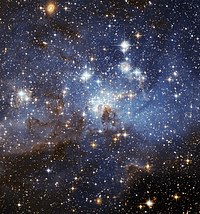
Photo from wikipedia
Filamentary structures are often identified in column density maps of molecular clouds, and appear to be important for both low- and high-mass star formation. Theoretically, these structures are expected to… Click to show full abstract
Filamentary structures are often identified in column density maps of molecular clouds, and appear to be important for both low- and high-mass star formation. Theoretically, these structures are expected to form in regions where the supersonic cloud-scale turbulent velocity field converges. While this model of filament formation successfully reproduces several of their properties derived from column densities, it is unclear whether it can also reproduce their kinematic features. We use a combination of hydrodynamical, chemical and radiative transfer modelling to predict the emission properties of these dynamically-forming filaments in the 13CO, HCN and N2H+J = 1 − 0 rotational lines. The results are largely in agreement with observations; in particular, line widths are typically subsonic to transonic, even for filaments which have formed from highly supersonic inflows. If the observed filaments are formed dynamically, as our results suggest, no equilibrium analysis is possible, and simulations which presuppose the existence of a filament are likely to produce unrealistic results.
Journal Title: Monthly Notices of the Royal Astronomical Society
Year Published: 2023
Link to full text (if available)
Share on Social Media: Sign Up to like & get
recommendations!